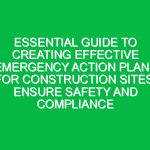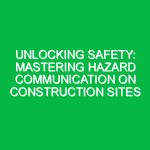Construction sites are bustling environments where safety is paramount. Among the myriad of hazards, respiratory risks stand out due to their insidious nature and long-term health implications. In the realm of Health Safety and Environment (HSE), ensuring robust respiratory protection for construction workers is not just a regulatory requirement; it’s a moral imperative. This article delves into essential tips and strategies to maximize safety and safeguard workers against respiratory hazards in construction work.
Understanding the Risks: The Importance of Respiratory Protection
Construction sites are rife with airborne hazards, including dust, fumes, gases, and vapors, which can lead to serious respiratory illnesses like silicosis, asbestosis, and chronic obstructive pulmonary disease (COPD). The first step in mitigating these risks is understanding them. Recognizing the specific hazards present on your construction site is crucial for implementing effective respiratory protection measures.
Identifying Respiratory Hazards in Construction
Common respiratory hazards in construction include:
- Crystalline silica from cutting, drilling, or grinding concrete and stone
- Asbestos in older buildings during renovation or demolition
- Welding fumes containing harmful metals and gases
- Wood dust from cutting and sanding
- Paints and solvents releasing volatile organic compounds (VOCs)
Identifying these hazards is the first step towards implementing effective control measures.
Implementing Control Measures: The Hierarchy of Controls
The Hierarchy of Controls is a framework used in HSE to manage workplace hazards, including respiratory risks. It prioritizes control measures based on their effectiveness:
Elimination and Substitution
Where possible, eliminate the hazard altogether. If not feasible, substitute hazardous materials or processes with safer alternatives. For instance, use water-based paints instead of those containing VOCs.
Engineering Controls
These involve modifying processes or equipment to reduce exposure to airborne hazards. Examples include using local exhaust ventilation systems to capture dust, fumes, and vapors at their source.
Administrative Controls
Implementing work practices and policies to limit exposure, such as scheduling work to minimize the number of workers exposed or providing adequate breaks in fresh air areas.
Personal Protective Equipment (PPE)
When other controls cannot fully mitigate risks, PPE, including respirators, becomes essential. It’s crucial to select the right type of respirator for the specific hazard and ensure it fits the wearer correctly.
Choosing the Right Respirator
Respirators are a key component of respiratory protection in construction. Selecting the right type is vital:
Types of Respirators
- Disposable Respirators: Also known as filtering facepieces, protect against particulates like dust and mist.
- Half-Face Respirators: Cover the nose and mouth, offering protection against gases, vapors, and particulates when equipped with the appropriate filters.
- Full-Face Respirators: Cover the entire face, providing the same protection as half-face respirators but with added eye protection.
- Powered Air-Purifying Respirators (PAPRs): Use a battery-powered blower to pass contaminated air through filters, supplying clean air to the wearer.
Fit Testing and Training
Ensuring a proper fit is crucial for the effectiveness of respirators. Workers should undergo fit testing before using a respirator and receive training on its correct use, maintenance, and limitations.
Maintaining Respiratory Protection Equipment
Proper maintenance is essential for the effectiveness and longevity of respiratory protection equipment:
Cleaning and Disinfecting
Respirators should be regularly cleaned and disinfected according to the manufacturer’s instructions to prevent contamination and ensure proper functioning.
Inspection and Replacement
Regularly inspect respirators for signs of wear and tear. Replace damaged parts or the entire respirator as needed to maintain protection.
Creating a Culture of Safety
Maximizing safety on construction sites requires more than just providing equipment; it necessitates creating a culture of safety where every worker understands the importance of respiratory protection and feels empowered to take the necessary precautions.
Encouraging Open Communication
Workers should feel comfortable reporting hazards, suggesting improvements, and asking questions about respiratory protection without fear of reprisal.
Continuous Training and Education
Regular training sessions reinforce the importance of respiratory protection and keep workers informed about best practices and new technologies.
Conclusion: Breathing Easy on Construction Sites
Respiratory hazards are a significant concern in construction work, but with the right strategies, they can be effectively managed. By understanding the risks, implementing the hierarchy of controls, choosing and maintaining the correct respirators, and fostering a culture of safety, construction sites can become safer environments for all workers. Remember, when it comes to respiratory protection, complacency is the enemy. Stay vigilant, stay informed, and ensure every breath your workers take is a safe one.
Summary of Key Points
- Identify specific respiratory hazards present on construction sites.
- Implement control measures following the Hierarchy of Controls, prioritizing elimination and substitution.
- Select the right type of respirator based on the hazard and ensure a proper fit.
- Maintain respiratory protection equipment through regular cleaning, inspection, and replacement.
- Create a culture of safety that promotes open communication and continuous training.
By adhering to these essential tips for respiratory protection in construction work, we can safeguard the health and well-being of our workforce, ensuring that safety is always the foundation upon which we build.


